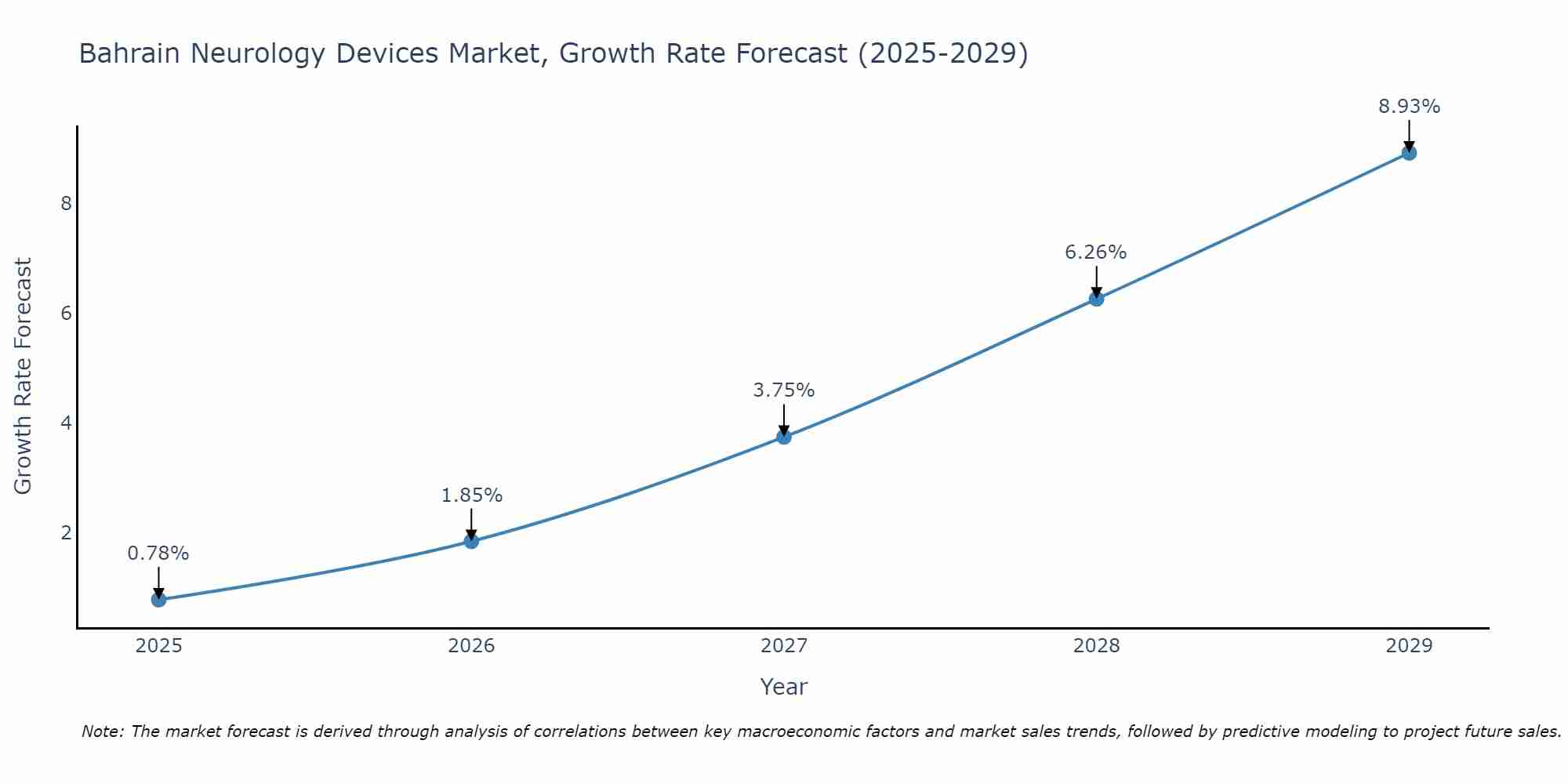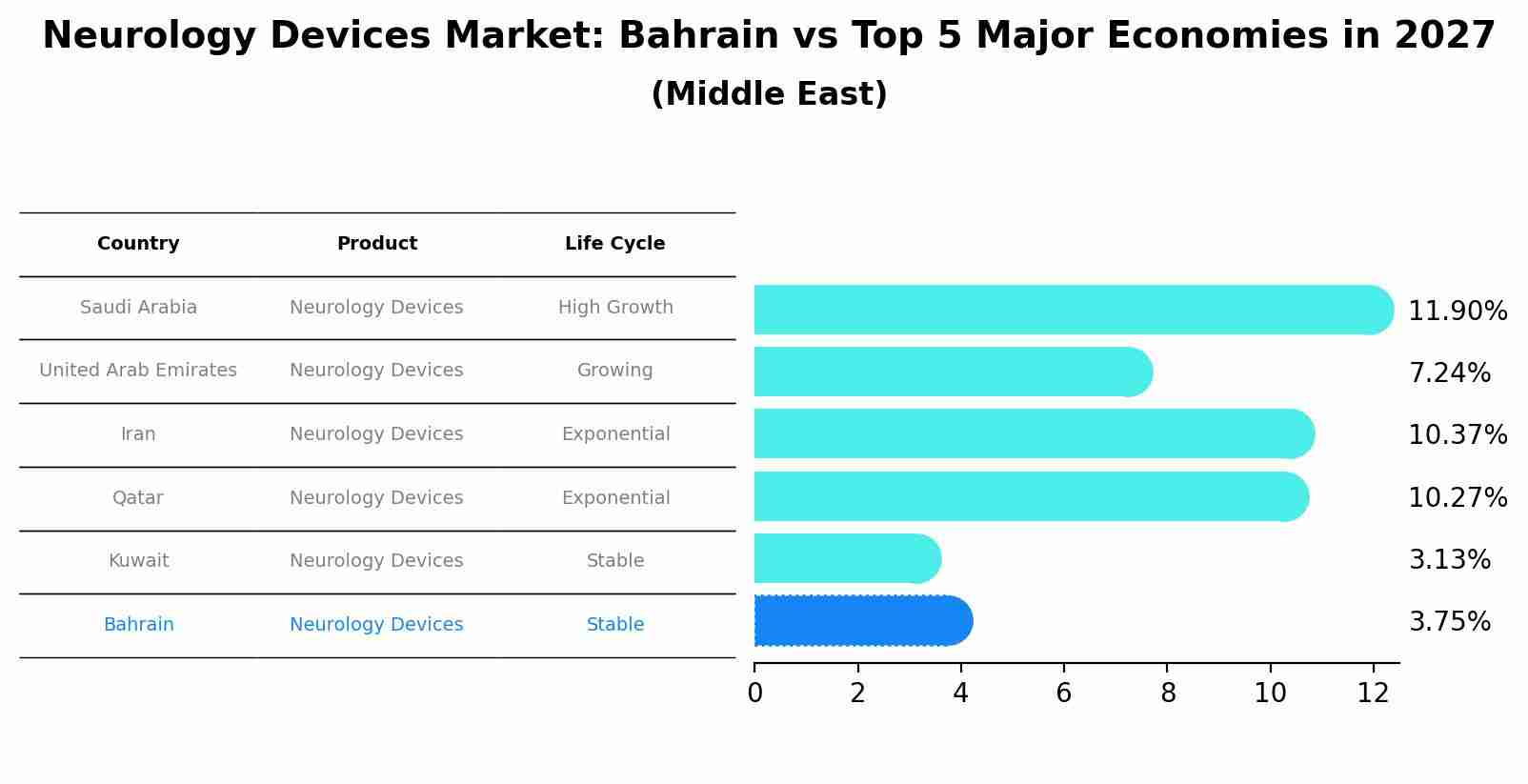Bahrain Neurology Devices Market Outlook | Size, Analysis, COVID-19 IMPACT, Growth, Value, Industry, Trends, Revenue, Forecast, Share & Companies
| Product Code: ETC367664 | Publication Date: Aug 2022 | Updated Date: Apr 2025 | Product Type: Market Research Report | |
| Publisher: 6Wresearch | Author: Shubham Padhi | No. of Pages: 75 | No. of Figures: 35 | No. of Tables: 20 |
Bahrain Neurology Devices Market Size Growth Rate
The Bahrain Neurology Devices Market is likely to experience consistent growth rate gains over the period 2025 to 2029. Commencing at 0.78% in 2025, growth builds up to 8.93% by 2029.

Neurology Devices Market: Bahrain vs Top 5 Major Economies in 2027 (Middle East)
By 2027, the Neurology Devices market in Bahrain is anticipated to reach a growth rate of 3.75%, as part of an increasingly competitive Middle East region, where Saudi Arabia remains at the forefront, supported by United Arab Emirates, Iran, Qatar and Kuwait, driving innovations and market adoption across sectors.

Bahrain Neurology Devices Market
The Bahrain Neurology Devices Market is witnessing steady growth propelled by the increasing prevalence of neurological disorders and the growing adoption of advanced medical technologies for diagnosis and treatment. Neurology devices encompass a wide range of medical devices and equipment used to assess, monitor, and manage neurological conditions such as epilepsy, stroke, and Parkinson`s disease. In Bahrain, healthcare providers are investing in neurology devices to improve patient outcomes, enhance diagnostic accuracy, and optimize clinical workflows, driving demand for innovative and cost-effective solutions from leading medical device manufacturers operating in the Bahrain market.
Drivers of the market
The increasing prevalence of neurological disorders and the growing aging population are driving the demand for neurology devices in Bahrain. Healthcare providers are investing in diagnostic and therapeutic devices such as EEG machines, MRI scanners, and deep brain stimulators to improve patient care and outcomes.
Challenges of the market
The Bahrain Neurology Devices market confronts challenges related to regulatory compliance, accessibility, and affordability. One significant challenge is ensuring the safety and efficacy of neurology devices used for diagnosis, treatment, and monitoring of neurological disorders. As Bahrain strives to enhance healthcare infrastructure and services, stakeholders face challenges in navigating regulatory requirements and obtaining approvals for neurology devices that meet quality and safety standards. Moreover, ensuring accessibility and affordability of neurology devices poses challenges, particularly for underserved populations and healthcare facilities in remote areas, requiring innovative approaches to improve distribution channels and reduce costs.
Government Policy of the market
Ensuring access to advanced medical technologies is a priority for Bahrain government, reflected in policies supporting the adoption of neurology devices. Regulations governing healthcare standards and reimbursement policies contribute to market growth by incentivizing investments in diagnostic and therapeutic neurology devices, improving patient outcomes and healthcare delivery.
Key Highlights of the Report:
- Bahrain Neurology Devices Market Outlook
- Market Size of Bahrain Neurology Devices Market, 2024
- Forecast of Bahrain Neurology Devices Market, 2031
- Historical Data and Forecast of Bahrain Neurology Devices Revenues & Volume for the Period 2018 - 2031
- Bahrain Neurology Devices Market Trend Evolution
- Bahrain Neurology Devices Market Drivers and Challenges
- Bahrain Neurology Devices Price Trends
- Bahrain Neurology Devices Porter's Five Forces
- Bahrain Neurology Devices Industry Life Cycle
- Historical Data and Forecast of Bahrain Neurology Devices Market Revenues & Volume By Product for the Period 2018 - 2031
- Historical Data and Forecast of Bahrain Neurology Devices Market Revenues & Volume By Neurostimulation Devices for the Period 2018 - 2031
- Historical Data and Forecast of Bahrain Neurology Devices Market Revenues & Volume By Neurosurgery Devices for the Period 2018 - 2031
- Historical Data and Forecast of Bahrain Neurology Devices Market Revenues & Volume By Interventional Neurology Devices for the Period 2018 - 2031
- Historical Data and Forecast of Bahrain Neurology Devices Market Revenues & Volume By Cerebrospinal fluid management devices for the Period 2018 - 2031
- Historical Data and Forecast of Bahrain Neurology Devices Market Revenues & Volume By Others for the Period 2018 - 2031
- Historical Data and Forecast of Bahrain Neurology Devices Market Revenues & Volume By End User for the Period 2018 - 2031
- Historical Data and Forecast of Bahrain Neurology Devices Market Revenues & Volume By Hospitals for the Period 2018 - 2031
- Historical Data and Forecast of Bahrain Neurology Devices Market Revenues & Volume By Ambulatory surgery centers for the Period 2018 - 2031
- Historical Data and Forecast of Bahrain Neurology Devices Market Revenues & Volume By Neurology clinics for the Period 2018 - 2031
- Bahrain Neurology Devices Import Export Trade Statistics
- Market Opportunity Assessment By Product
- Market Opportunity Assessment By End User
- Bahrain Neurology Devices Top Companies Market Share
- Bahrain Neurology Devices Competitive Benchmarking By Technical and Operational Parameters
- Bahrain Neurology Devices Company Profiles
- Bahrain Neurology Devices Key Strategic Recommendations
Frequently Asked Questions About the Market Study (FAQs):
- Single User License$ 1,995
- Department License$ 2,400
- Site License$ 3,120
- Global License$ 3,795
Search
Thought Leadership and Analyst Meet
Our Clients
Related Reports
- Afghanistan Apparel Market (2026-2032) | Growth, Outlook, Industry, Segmentation, Forecast, Size, Companies, Trends, Value, Share, Analysis & Revenue
- Canada Oil and Gas Market (2026-2032) | Share, Segmentation, Value, Industry, Trends, Forecast, Analysis, Size & Revenue, Growth, Competitive Landscape, Outlook, Companies
- Germany Breakfast Food Market (2026-2032) | Industry, Share, Growth, Size, Companies, Value, Analysis, Revenue, Trends, Forecast & Outlook
- Australia Briquette Market (2025-2031) | Growth, Size, Revenue, Forecast, Analysis, Trends, Value, Share, Industry & Companies
- Vietnam System Integrator Market (2025-2031) | Size, Companies, Analysis, Industry, Value, Forecast, Growth, Trends, Revenue & Share
- ASEAN and Thailand Brain Health Supplements Market (2025-2031) | Strategy, Consumer Insights, Analysis, Investment Trends, Opportunities, Growth, Size, Share, Industry, Revenue, Segments, Value, Segmentation, Supply, Forecast, Restraints, Outlook, Competition, Drivers, Trends, Demand, Pricing Analysis, Competitive, Strategic Insights, Companies, Challenges
- ASEAN Bearings Market (2025-2031) | Strategy, Consumer Insights, Analysis, Investment Trends, Opportunities, Growth, Size, Share, Industry, Revenue, Segments, Value, Segmentation, Supply, Forecast, Restraints, Outlook, Competition, Drivers, Trends, Demand, Pricing Analysis, Competitive, Strategic Insights, Companies, Challenges
- Europe Flooring Market (2025-2031) | Outlook, Share, Industry, Trends, Forecast, Companies, Revenue, Size, Analysis, Growth & Value
- Saudi Arabia Manlift Market (2025-2031) | Outlook, Size, Growth, Trends, Companies, Industry, Revenue, Value, Share, Forecast & Analysis
- Uganda Excavator, Crane, and Wheel Loaders Market (2025-2031) | Strategy, Consumer Insights, Analysis, Investment Trends, Opportunities, Growth, Size, Share, Industry, Revenue, Segments, Value, Segmentation, Supply, Forecast, Restraints, Outlook, Competition, Drivers, Trends, Demand, Pricing Analysis, Competitive, Strategic Insights, Companies, Challenges
Industry Events and Analyst Meet
Whitepaper
- Middle East & Africa Commercial Security Market Click here to view more.
- Middle East & Africa Fire Safety Systems & Equipment Market Click here to view more.
- GCC Drone Market Click here to view more.
- Middle East Lighting Fixture Market Click here to view more.
- GCC Physical & Perimeter Security Market Click here to view more.
6WResearch In News
- Doha a strategic location for EV manufacturing hub: IPA Qatar
- Demand for luxury TVs surging in the GCC, says Samsung
- Empowering Growth: The Thriving Journey of Bangladesh’s Cable Industry
- Demand for luxury TVs surging in the GCC, says Samsung
- Video call with a traditional healer? Once unthinkable, it’s now common in South Africa
- Intelligent Buildings To Smooth GCC’s Path To Net Zero


















